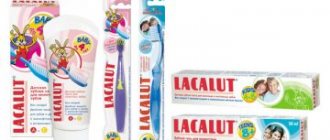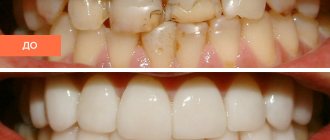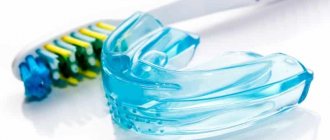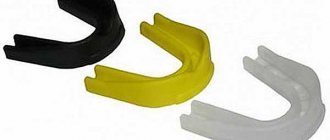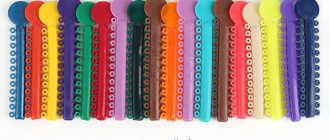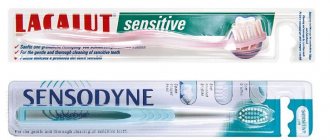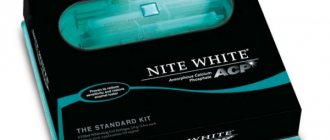Orthodontic aligners for teeth
These are structures for aligning the dentition, which are made according to individual casts of the patient’s jaws. Unfortunately, not all such mouthguards for correcting bites are able to cope with serious anomalies. They are mainly effective for eliminating interdental gaps and correcting some malocclusion pathologies. However, when it comes to Invisalign® orthodontic aligners, they can be safely considered as an alternative to braces. See photos of dental aligners below.
Photos of aligners
Teething trays
There is another type of dental trays for straightening teeth - trainers. They are also called teething trays, teething guides or LM activators. Various models of this type of mouth guard are made from silicone. They come in several sizes. Despite the name, teething mouth guards are actually used to correct the jaw relationship and align the incisors in children aged 6 – 10 years, that is, in the early mixed dentition stage. How long to wear dental guards? The mouth guards must be worn by the child for several hours during the day and throughout the night. The treatment period is usually about a year with periodic monitoring of intermediate results based on impressions of the jaws made at different stages of correction.
Teeth whitening trays
If you want to achieve a snow-white smile, but in-office whitening procedures in a clinic are not suitable for you for some reason, you can make your teeth whiter at home using professional systems using a customized, standard or thermoplastic disposable dental tray and whitening gel. However, in this case, you will still need to visit your dentist to take impressions for a custom mouthguard or to simply learn how to use dental aligners. At the same time, you must be prepared for the fact that the whitening process using this technology will not be fast and will take at least a month, since the percentage of hydrogen peroxide in the gel is lower than that of in-office whitening systems. But this method is considered the most suitable for teeth with increased sensitivity.
How to put a mouth guard on your teeth for home whitening? First, you need to brush your teeth, apply the gel to the inside of the mouthguard and put it on, pressing slightly so that the gel is distributed evenly. After this, you need to rinse your mouth and wear the mouth guard for the time specified in the instructions. Then the mouthguard should be removed and the mouth should be rinsed with water again.
Mouthguard for applications on teeth
Trays for dental applications are also used for remineralization procedures. A special gel or paste is applied to the inner surface of the mouth guard and pressed tightly against the teeth. Regular wearing of a device filled with a mineralizing composition can effectively strengthen and restore tooth enamel. These mouth guards come in standard and thermoplastic types. Thermoplastic dental mouthguard is made from a flexible material that softens when immersed in hot water. After this, it is immediately put on the teeth, and the material hardens. To learn how to make a mouth guard for your teeth, watch the video below.
Photos of individual trays for whitening and mineralization
Mouthguard for athletes made of silicone
Such mouthguards are used to protect teeth in contact or extreme sports - football, hockey, boxing. Sports mouthguards are worn over the front teeth and reduce the strong physical impact not only on the teeth, but also on soft tissues and even the cervical spine.
Based on manufacturing methods, there are two types of sports mouthguards:
1. Standard sports mouth guard
Sold in any sports stores, made the same for everyone.
2. Individual sports mouth guard.
It is made individually for a specific person using impressions of his teeth, taking into account their anatomical shape. They cost much more, but are also much more convenient, since they fit on the teeth “like family.”
Why Invisalign? Brand benefits
Invisalign has gained popularity among dentists around the world and their patients due to its effectiveness and discreet wearing. Main advantages of the brand:
Dental mouth guard
Unlike a sports mouthguard, which is used only for impact protection, a dental mouthguard has a wider range of applications. A dental mouth guard is made from special plastic materials – silicone or polyurethane.
The convenience of the mouth guard is that it can be used to solve many problems - from therapeutic to orthodontic treatment. And at the same time, the mouthguards are convenient to use - the patient can take them off and put them on himself, according to the schedule established by the attending physician.
How many trays may be needed to correct a bite?
How many trays are included in the bite correction kit? The answer to this question will depend on two main factors:
- Difficulties in malocclusion that needs to be corrected;
- Patient's age. The older a person is, the longer orthodontic treatment can be, because after the final formation of the dental system, tooth displacement occurs more slowly. That’s why dentists recommend correcting your bite in childhood and adolescence!
Thus, a full course may require about 15-40 pairs of mouth guards, and each mouth guard will have its own shape and size. To correct the bite, the mouthguards are changed every 2-3 weeks.
Regular change of aligners when correcting a bite is necessary: it allows you to achieve the tightest possible fit of the structure to the teeth. Due to the high density of the mouth guards, they will exert pressure on the teeth, which will cause the teeth to shift in the desired direction. As soon as the pressure becomes insignificant, the used mouth guards are replaced with a new pair.
Orthodontic dental guards
These aligners are used to correct malocclusions. At the moment, there are several types of orthodontic aligners on the market from different manufacturers, including Star Smile aligners, the well-known aligners.
But not all orthodontic aligners are capable of solving serious bite problems; they only help to close the spaces between the teeth and correct minor curvatures.
Much has changed when Russian-made orthodontic mouthguards or aligners from the Star Smile company appeared; they became serious competitors to braces, since they can correct almost all defects in the development of bite.
Types of mouthguards for correcting bite
Orthodontic mouthguards for correcting bites have their own classification. They are divided into different types according to the following characteristics:
— Material of production. Mouthguards for correcting bites can be made of silicone or polyester;
- Production technology. On this basis, standard and individual dental guards are distinguished.
Each type of mouthguard for correcting the bite has its own characteristics, which will be useful for people planning to undergo orthodontic treatment.
Children's mouth guards for proper teething
These are silicone overlays for teeth, which are also called, among others. retainers, trainers. They are called teething mouthguards because they are most often used during the period of change of baby teeth to molars in children aged six to ten years.
The main purpose of teething trays or teething guides is to correct the position of the jaws and align the position of the child’s incisors during the period of early mixed dentition. They are worn for several hours during the day and all night while sleeping. The treatment period is approximately one year; during treatment, it is necessary to periodically visit an orthodontist to monitor the changes occurring.
Also, during the period of mixed dentition, children's aligners are used - children's orthodontic aligners. Since 2022, such mouthguards have been produced by the Star Smile company.
Treatment using aligners
Corrective therapy in our dental departments is carried out according to the following algorithm:
- Visit to an orthodontist by appointment. Important: treatment is possible only with a completely sanitized oral cavity;
- visual and hardware diagnostics in order to identify indications or contraindications for treatment with mouth guards;
- if indicated, the doctor performs a 3-D scan of both jaws of the patient to subsequently create a computer model of them, and also draws up a detailed correction plan;
- production of a set of mouth guards in America at the Aling Technology plant according to individual patient data;
- sending finished aligners to our clinic;
- starting a course of corrective therapy. The doctor explains the rules of wearing and care, sets the date for the next visit;
- Every 1 – 2 weeks the patient himself changes the mouthguard to the next one from the kit in numbering order.
Teeth whitening trays
There are at-home teeth whitening systems that also use dental trays. Whitening trays can be customized, standard, or disposable. Before using any whitening system, you should visit your dentist to determine what is right for you and will not harm your tooth enamel.
An individual mouthguard is made personally for the patient based on impressions of his teeth. For whitening, a special gel is used that is placed inside the tray.
Whitening at home usually takes longer than at the dentist's office because the gel used at home contains less hydrogen peroxide.
The whitening procedure should be carried out strictly according to the instructions provided. The gel is placed on the inside of the mouth guard, after which the mouth guard is put on and specially pressed to distribute the gel evenly. After putting it on, rinse your mouth with water and wear the mouthguard exactly as long as the instructions say. After removing the whitening tray, you should also rinse your mouth with water.
Advantages and disadvantages of using mouth guards to correct bites
Mouthguards for correcting bites have a number of advantages that make orthodontic treatment comfortable and convenient for patients:
— Mouthguards are removable structures, and this provides a number of advantages. Firstly, the mouth guard can be easily removed before an important meeting or special event, and secondly, this allows for high-quality oral hygiene and comfortable eating. You simply remove the mouth guard while eating for quality cleansing;
— The process of adaptation to mouth guards for correcting malocclusion proceeds quite quickly. In just 2-3 days you will stop noticing the aligners on your teeth;
— Wearing aligners does not cause problems with diction and does not interfere with active communication;
— The elastic material of the mouth guard does not injure the soft tissues of the oral cavity, does not cause allergic reactions and does not have a negative effect on tooth enamel;
— Mouthguards for correcting bites are made from transparent materials and therefore they are invisible on the teeth;
— The structures are easily cleaned from food debris and plaque;
— Correcting your bite with mouth guards can be combined with teeth whitening: to do this, just apply a special whitening gel to the inner surface of the product.
Treatment of bite defects with mouthguards is possible at any age and has fewer indications than therapy using traditional braces. But in addition to the advantages, mouth guards for correcting bites also have some disadvantages that are important to consider before starting treatment.
Among them:
— Mouthguards cannot correct serious malocclusions;
— It will take a long time to produce a full set of mouth guards to correct your bite.
It is worth noting that the price of correcting a bite with aligners may be more expensive than treatment with braces.
Applications on teeth using trays
These mouth guards are used to restore and strengthen tooth enamel. A special composition is placed inside the mouthguard, thanks to which the teeth are remineralized.
There are two types of mouth guards for dental applications – standard and thermoplastic.
Thermoplastic ones react to heat and soften when placed in hot water, and harden when put on the teeth.
Neutralization of bruxism
Bruxism affects up to 60% of children and about 12% of adults. But the data for adults is unreliable - who will record this phenomenon in lonely people in old age, when they are left alone? So the problem can be considered global; this condition occurs in people of all ages, genders and races, and regardless of their social status.
The load on the teeth during grinding with their gradual loosening, as well as the abrasion and crumbling of the enamel, can be neutralized by a mouthguard applied before bedtime.
Mouthguards for night teeth grinding
Bruxism or nighttime teeth grinding is one of the serious diseases that affects approximately 3% of the world's population. The reasons for this have not been fully identified, but the consequences can be very serious - from abrasion of tooth enamel to deformation of the jaw joints. Wearing special mouth guards allows you to protect your teeth from premature wear, relieve muscle tension, and reduce headaches. For the effect to be effective, the mouth guards should be worn for up to 10 hours a day.
Mouthguards for the treatment of teeth grinding are distinguished by the time of their use. There are day guards that are worn during the day; they are transparent and almost invisible.
There are night guards that you wear while you sleep. They may differ in shape from daily mouth guards, but are also comfortable and imperceptible in the mouth.
Type No. 6: for bruxism and hypertonicity of the masticatory muscles
This type of mouthguard is necessary for people who experience involuntary strong jaw clenching during sleep and have pathologies of the TMJ, manifested by decreased muscle tone or hypertonicity. With this disease, which is partly of a neuropsychic nature, various dental problems develop, among others, the enamel wears down and crumbles, and restorations in the mouth do not last long.
To avoid the consequences of bruxism for the dental system, to keep various orthopedic devices in the oral cavity and treated teeth intact, as well as to relieve tension from the muscles and ligaments, doctors, in combination with other measures, recommend acquiring special mouthguards - these are made in the dental laboratory of the dental clinic based on jaw casts.
Retainer or mouthguard
After aligning the bite using braces or aligners, you must wear a special mouth guard or retainer that secures the result. In appearance, this tray looks like an aligner, only very, very smooth and even.
Retention aligners are made from special biopolymers; they are easy to use and almost invisible. These mouth guards are worn at night and worn for several hours during the day. The timing of wearing retainers is individual and depends on the degree of development of the malocclusion.
Wearing retaining trays after braces and aligners is mandatory, and this is the only way you can be sure that the teeth will not return to their original incorrect position.
Duration and effectiveness of treatment with mouthguards for correcting malocclusion
The timing of treatment will depend primarily on the complexity of the malocclusion that needs to be corrected. The average duration of aligner therapy in adult patients is 1 year. This is taking into account your disciplined approach to treatment! The orthodontist will definitely calculate the approximate time frame for the general course of correction when drawing up a treatment plan!
Mouthguards for correcting bites are effective in correcting mild anomalies; if you need to eliminate severe crowding of teeth or serious pathology, it is optimal to plan treatment using classic braces.
Luminous decorative burls
Here manufacturers have a wide range of options, as they say - for every taste and color. And even light, which, thanks to technology, is now built into mouth guards.
Of course, in this case we are not talking about the benefits of mouth guards, but about entertainment. You can wear them to a disco or surprise others at a friendly party.
Possible causes of bruxism
- Congenital or acquired defects of the jaw caused by colds, infectious diseases or injuries.
- Dental problems. Uncomfortable dentures and braces, unsuccessfully installed fillings made of poor quality material, incorrect bite. With the latter, a person unconsciously tries to put his teeth in the correct position, and since the process is not controlled, the chewing surfaces make a grinding sound.
- It is possible that there are worms in the body - the relationship with this is not obvious, but parasites always cause a deficiency of B vitamins, and their deficiency, in turn, affects problems with emotional stability.
- Psychological trauma or prolonged stress, psychosis, depression, which can cause spasm in the masticatory-jaw muscles.
If in children bruxism is most often caused by physiological reasons, then in adults it is caused by psychological ones.
In this regard, the opinions of psychoneurologists are interesting: according to them, during the day a person is distracted from his pathological state by many problems, but the muscles “remember” their usual work and as soon as peace sets in, the affective charge accumulated during the day is realized in attacks of bruxism.
How to care for your mouthguards
Typically, mouthguards do not require special care. Modern dental mouth guards often just need to be rinsed with running water. Less often they need to be cleaned with toothpaste and a brush. When using orthodontic aligners, the doctor will definitely advise you on how to care for them.
Sports mouthguards require slightly different care and are stored in separate containers and periodically placed in a special solution to extend their life. Any sports mouthguard comes with its own instructions for use and care.
Application trays have their own service life and, as a rule, are not designed for long-term use.
It is enough to wash decorative mouth guards after use under running water, or, in extreme cases, with soap or brush them with a toothbrush.
What it is?
Aligners in dentistry are soft and elastic devices in the form of a toothbrush, which have an arched shape and contain from 28 to 32 caps (according to the number of teeth in the mouth). Such structures are made individually based on an impression that the orthodontist makes during the initial appointment. If a patient is diagnosed with infectious and inflammatory diseases of the gums and teeth, they are first treated (opening and draining abscesses, stopping inflammatory processes, filling teeth, etc.).
Aligners are made individually
Bioplastic is used as the main material in the manufacture of aligners. This is a soft and elastic plastic made from vegetable oils, corn starch, biomatter using microorganisms. The most practical and convenient are mouthguards made of polycarbonates (mixed polyesters of carbonic acid and dihydric alcohol), made by thermoforming. Such aligners are characterized by increased strength, resistance to external influences and a minimal degree of trauma to the soft tissues of the oral cavity.
How do aligners work?
The main difference between dental aligners and braces is the ability to remove the device without visiting a dental office. The mouth guard can be removed from the mouth at any time, which helps eliminate psychological discomfort and ensures a higher quality of hygiene during the treatment period.
Installation of braces
Other characteristics of dental trays:
- The period of use of the aligners is calculated individually and ranges from 8-10 months to 2 years;
- mouth guards must be changed regularly (the interval between changes ranges from 2-4 weeks to 3 months);
- The device is cleaned in the traditional way (rinsing with soapy water and brushing with a toothbrush);
- Pain and discomfort characteristic of the initial period of getting used to braces are absent when using mouth guards.
Mouthguard for correcting bite (aligner)
A person stops feeling the mouthguard in his mouth within 5-30 minutes after putting it on. In exceptional cases, longer adaptation is possible - up to several hours - but no more than 5-8% of patients encounter this problem.
Important! The only disadvantage of soft teethers is moderate discomfort during a conversation, which can persist for several days after the initial installation of the device. A silicone or polycarbonate mouth guard thickens the dentition, which in some patients affects the quality of speech and diction. Adaptation to this property of aligners rarely lasts longer than 3-5 days.
Photos before and after treatment with aligners
How to purchase a mouth guard for dental protection or treatment
Standard sports mouthguards can be purchased at almost any sports store. If you are trying to find a quality product, then you should read reviews on various forums or contact a dentist to have custom mouth guards made. This is what all professional athletes do.
Mouthguards for teeth whitening and treatment of certain diseases can be purchased at the pharmacy. But before starting use, it is still better to consult an appropriate doctor to evaluate all possible treatment options and choose a safer and more effective one.
It is better to order mouth guards for teeth straightening individually from well-known and trusted manufacturers, so as not to waste money and not cause more harm to your health.
Type No. 7: sports
And, perhaps, the most famous type of mouth guard.
This is again a device in the form of an overlay that is tightly fixed to the entire dentition and can be easily removed from the mouth if necessary. It looks much more massive than all previous options, but its purpose is completely different - to protect teeth, restorations, as well as orthopedic and orthodontic devices installed in the mouth from various damages.
A sports design is simply necessary for people involved in sports where there is a high risk of injury and a blow to the head. According to statistics, during traumatic and active sports, people most often experience dental problems such as crown fracture[1], tooth dislocation or bruise, and tooth loss.
Notice
: Undefined variable: post_id in
/home/c/ch75405/public_html/wp-content/themes/UltraSmile/single-item.php
on line
45 Notice
: Undefined variable: full in
/home/c/ch75405/public_html/wp-content /themes/UltraSmile/single-item.php
on line
46
Rate this article:
braces
[1] Chernyshov I.I. Orthopedic dentistry in sports. Means of protection of the maxillofacial area. // Bulletin of medical Internet conferences. – 2022.
Cost of individual mouthguards
The price of individual mouthguards, both sports and medical, is much higher than similar designs made according to the same template in the factory. It depends on the material and manufacturing method, as well as the manufacturing company.
(in the case when a custom design is produced abroad).
Orthodontic treatment using custom aligners will cost even more because it has many components, the main one being its duration. It depends on the complexity of the clinical case. The more difficult it is to correct the pathology, the more aligners and visits to the doctor will be needed, which will ultimately affect the final cost of therapy.
The process of making a custom mouth guard
The production process of individual mouthguards takes place in several stages.
· Taking impressions. Based on them, a working model is made in the laboratory, scanned and a three-dimensional image is displayed on a computer.
· Development of a treatment plan. At this stage, the doctor, using a special program, predicts the results of treatment and, based on them, determines how many individual trays the patient will need.
· Manufacturing of structures. In accordance with the predicted results of treatment, a set of individual mouth guards is made for the patient. They are packaged in a special container and sent to the doctor.
The patient puts on the first mouthguard at the appointment. The doctor gives him recommendations and sets the next date for his visit.
